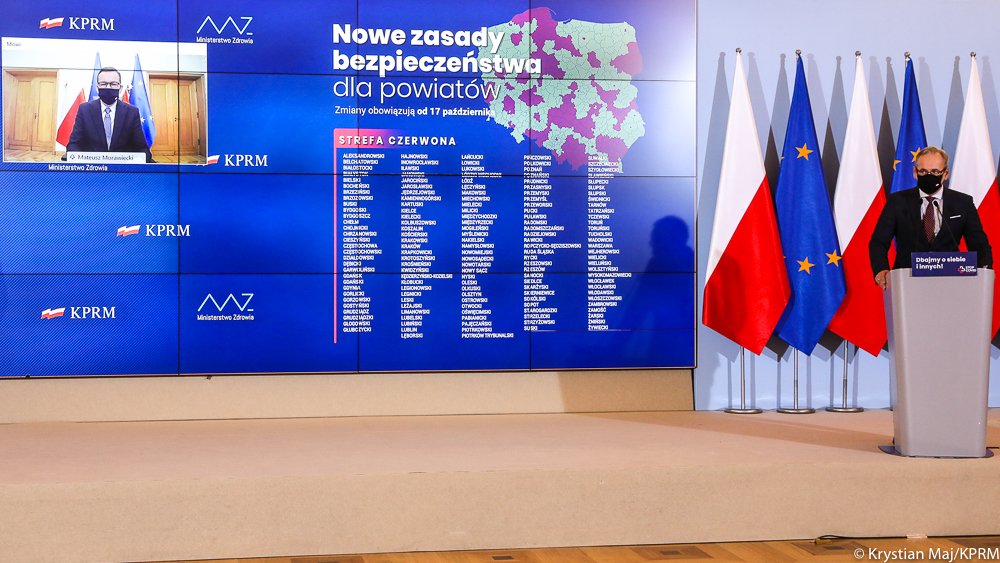Poland’s prime minister – speaking via video link due to currently being in quarantine – has announced a set of new restrictions as the government seeks to tackle what it admits is an “exponential” rise in coronavirus infections.
Among the new measures nationwide (which are listed in full below) are a requirement for restaurants to close at 9 p.m., secondary schools and universities to move partially online, the closure of gyms, and restrictions on attendance at religious ceremonies and cultural events.
In areas classified as “red zones” due to particularly high infection rates, even tougher measures are in place, including limits on the numbers of customers allowed in shops and secondary schools and universities having to teach completely online.
Lista powiatów i miast objętych nowymi zasadami w strefie 🔴 czerwonej ⤵️
Więcej informacji: https://t.co/17ZoDC0nS0 pic.twitter.com/GLr5rJhEEC
— Kancelaria Premiera (@PremierRP) October 15, 2020
An updated list published today alongside the new restrictions shows that almost half of Poland is now classified as a red zone, including large cities such as Warsaw, Kraków, Poznań, Łódż, Gdańsk and Lublin.
The new measures come after Poland today once again recorded its highest ever daily number of new coronavirus cases. The total, 8,099, was 24% higher than the previous record, set yesterday, of 6,526.
The numbers of deaths recorded today (91) and yesterday (116) are also the highest since the start of the pandemic, as are the current figures for active cases (61,007), hospitalisations (6,538) and occupied ventilators (508).
In yellow zones (meaning the whole country except for red zones), in addition to existing restrictions (such as the requirement to wear masks in outdoor public areas), the following new regulations have been introduced, taking effect on Saturday 17 October:
- Premises offering food allowed to open between the hours of 6 a.m. and 9 p.m., with only every second table available. After 9 p.m., only takeaway and delivery services can be offered
- Only 50% of seats or 30% of all spaces in public transport allowed to be occupied
- A limit of 20 people at wedding receptions and other private celebrations and no dancing allowed (taking force from Monday 19 October)
- Attendance at religious ceremonies limited to one person per 4 square metres of space
- Public assemblies limited to 25 people
- Universities and secondary schools moving to hybrid (online and in-person) teaching
- No audiences at sporting events
- Only 25% of seats at cultural events to be occupied
- Gyms, swimming pools and water parks to be closed
Od 17 października obowiązują nowy zasady bezpieczeństwa w strefie 🟡żółtej: pic.twitter.com/D2SYDwXbyB
— Kancelaria Premiera (@PremierRP) October 15, 2020
In areas classified as red zones, as well as the above and previously existing restrictions, the following regulations will take force from Saturday 17 October:
- The number of people in retail outlets limited to 5 per cash desk
- A ban on wedding receptions and other private celebrations (taking force from Monday 19 October)
- Attendance at religious ceremonies limited to one person per 7 square metres of space
- Public assemblies limited to 10 people
- Universities and secondary schools moving to entirely remote teaching (excluding practical classes)
Od 17 października obowiązują nowe zasady bezpieczeństwa w strefie 🔴czerwonej: pic.twitter.com/oDXZtLBm60
— Kancelaria Premiera (@PremierRP) October 15, 2020
A previously announced measure that came into force today is “senior hours” in shops. Between 10 a.m. and 12 noon, only those aged over 60 will be allowed to enter grocery stores, pharmacies and post offices.
“I am sure that, as a society, we will win this fight, but only if we stand with the recommendations that we are implementing today,” said the prime minister, Mateusz Morawiecki, announcing the new measures.
He was speaking via a video link due to currently bring in quarantine after coming into contact with an infected person. He himself has so far returned one negative coronavirus test after entering isolation.
Premier @MorawieckiM: Jestem pewien, że jako społeczeństwo jesteśmy w stanie w czasie tych kilku tygodni pokazać ogromną solidarność w obliczu epidemii. Wygramy tę walkę, ale wygramy ją tylko wtedy, kiedy solidarnie podejdziemy do tych zaleceń i rygorów, które dzisiaj wdrażamy. pic.twitter.com/p28JEo8jsG
— Kancelaria Premiera (@PremierRP) October 15, 2020
“The pandemic is accelerating exponentially,” added the health minister, Adam Niedzielski. Last week, Niedzielski admitted that the government “does not have everything under control”, saying it had “not expected such a large escalation”.
At the end of September, the head of the Chief Sanitary Inspectorate (GIS) predicted that by mid-October there would be around 1,000-1,500 new cases a day, and that the figure would then go into decline. “We are going in the right direction,” he said.
In actual fact, since 7 October the figure has exceeded 3,000 every day and is on an upward trend, today passing 8,000 for the first time. Poland also has a relatively low testing rate.
There have already been widespread reports of hospitals struggling to cope with demand for intensive care beds. In Kraków, those seeking coronavirus tests have had to queue for up to six hours outside the hospital.
A report published today in Dziennik Gazeta Prawna, a respected daily, warned that if infections continue to rise at their current rate, there will not be enough ventilators, and staff trained to use them, within two weeks.
Main image credit: Krystian Maj/KPRM

Daniel Tilles is editor-in-chief of Notes from Poland. He has written on Polish affairs for a wide range of publications, including Foreign Policy, POLITICO Europe, EUobserver and Dziennik Gazeta Prawna.



















